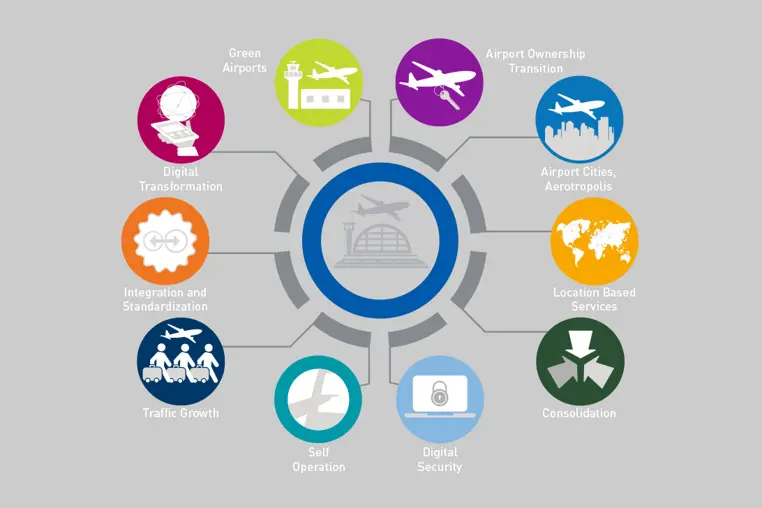1. Airport Ownership Transition
Airports are witnessing a transition in the ownership and management structure from public to public-private partnership, to a concession-based operator on behalf of the owner, and finally to fully private airports. This creates opportunities for larger investments towards airport development and in turn allows suppliers to penetrate deeper into the market with both existing and new products.
2. Airport Cities, Aerotropolis
Airports are transforming into a social hub where passengers can meet, rest, and experience an increasing array of airport services. Suppliers that form partnerships with service providers or those that diversify into the airport industry are able to introduce new platforms that can integrate with other sectors and provide a seamless and connected array of services.
3. Location-based Services
Targeted marketing, including information on store location and discounts in the airport, together with new purchasing models such as online purchases and offsite delivery of goods, will lead to increased non-aeronautical revenues for airports.
Suppliers have introduced passenger tracking and flow management systems and integrated personalized technology using Bluetooth and WiFi that identify the location of customers in relation to a store and provide information.
4. Consolidation
In the face of airport expansion and growing competition among suppliers, suppliers are consolidating their position in the industry by pushing their products into existing markets to gain a sizable market presence.
Suppliers build on this success by broadening into new market regions or developing and marketing new products in their existing regional presence.
A strong consolidation strategy is the foundation to diversifying into other market segments.
5. Digital Security
State-of-the-art technology has been used to develop advanced concepts such as “walk though security” to reduce passenger wait times, while biometrics can be used to automate verification processes and reduce staffing.
Security systems have rapidly become a major trend in airports. Suppliers have moved swiftly to incorporate cyber-security services into their IT solutions.
Suppliers are aggressively pushing security solution suites to get ahead of the competition and grow their market presence.
6. Self Operation
The evolution of passenger operations will lead to passengers performing all services from check-in to boarding the flight on their own. This will help to optimize resources, cut down on operating cost, and enhance non-aeronautical revenue.
Suppliers have developed new standardized products that enable such services including self-service platforms and e-boarding. Additionally, passengers will be able to manage their travel, including monitoring their baggage.
7. Traffic Growth
Driven by the emerging middle class, passenger traffic has doubled every 15 years. Forecasts have confirmed that this trend will continue. This results in the necessity to upgrade airport infrastructure.
The Asia-Pacific region has witnessed a booming air-travel population. As a result, suppliers have targeted this region to gain market presence, thus presenting opportunities for growth.
To undertake massive infrastructure upgrade projects, companies form consortiums with service providers from different segments.
8. Integration and Standardization
Integrated systems allow airports to use standardized platforms which seamlessly connect with platforms of other suppliers and with third-party applications.
Suppliers understand the importance of integrated platforms. Partnerships with other suppliers enable them to provide end-to-end platforms that integrate different airport segments.
Suppliers also resort to mergers or acquisitions to include new platforms into their portfolio and market their services as airport integrators.
9. Digital Transformation
The level of digitalization in airports is growing quickly and it supports trends such as increasing automation and targeted passenger services.
This will lead to a connected airport where the control center has visibility across all operations and can better monitor and manage performance against key performance indicators (KPIs).
Supplier provide a range of analytic services that integrate with all airport operations and engages airport operators to find ways to provide a seamless connectivity throughout the airport.
10. Green Airports
With high standards to limit noise and air pollution, airports will increasingly focus on generating energy through renewable sources and improving energy management solutions.
Suppliers such as Honeywell and Siemens have a strong building management service portfolio. Integration of such systems with their existing airport solutions will allow such companies to provide end-to-end airport integration and management services.
To get the latest insights, make sure to also read our new article on key trends: Looking forward to 2020 & beyond: top trends for airports and aviation.

